CES 2006 Part II - Sony Blu-Ray Disc, DTS-HD, Toshiba HD-DVD
By Chris Boylan
Blu-Ray Disc? HD-DVD? DTS-HD Plays Nicely with Both
On Wednesday, the official press day of CES,
Panasonic put on an impressive stage show in the main tent (Las Vegas Convention Center) with live dancers interacting with recorded performers - musicians, singers and dancers who appeared on a bank of forty-four 65-inch High Definition plasma displays.
As the topic of this song and dance number, Panasonic was touting a number of new products and product lines at CES including Blu-ray Disc home theater, with prototype BD recorders and players on display. Panasonic expects to ship Blu-ray players this Summer (2006). But like some other manufacturers at CES, pricing has not yet been announced.
Panasonic also showed off their prototype 103-inch plasma HDTV (1080p resolution) at the show which bests Korean rival Samsung who held the previous record at 102 inches.
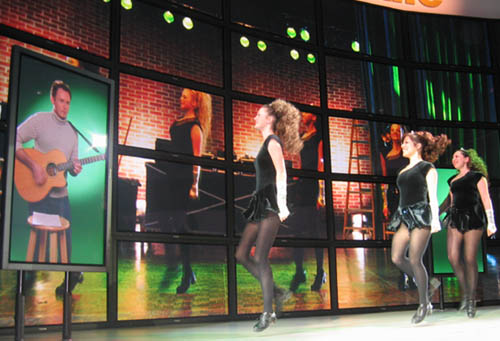
The lovely Panasonic dancers performed with pre-recorded peers on plasma monitors.
DTS publicly demonstrated their new DTS-HD Master Audio technology for the first time at CES. Along with Dolby Digital, DTS is a mandatory audio component on both the Blu-Ray Disc (BD) and HD-DVD high definition disc formats though it is up to the content providers (e.g, the movie studios and record labels) as to whether they will include DTS-HD tracks on their content.
At its heart, DTS-HD Master Audio is an efficient audio codec (coder/decoder) that supports "nearly unlimited" discrete channels of high resolution audio, to accompany the video components of high definition discs. In practice, DTS-HD will most likely involve 7.1 channels when deployed on disc-based high definition content. DTS-HD features a lossless encoding option which means that the encoded audio signal can provide an exact match of the original studio recording with no compression artifacts, up to 24 bits of digital precision and 192 KHz sampling rates.
DTS demonstrated some DTS-HD content in their theater display and the results were definitely encouraging. The DTS folks played new movie and music tracks encoded in DTS-HD, with 7.1 channel lossless audio combined with 1080p "super high definition" video. Then they brought up the artists, engineers and producers involved in making these tracks for an interactive Q&A session. DTS CEO John Kirchner welcomed recording artist/producer Omar Hakim, performer/actor Ice T, musician/producer Martyn Ware and recording engineer Nathaniel Kunkel to the panel to discuss why each person was excited to be working in the multi-channel audio arena.
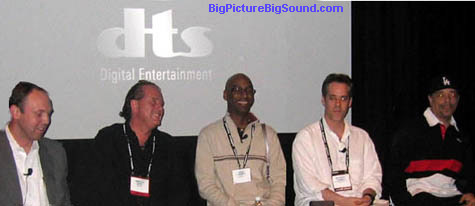
Pictured (left to right) are DTS CEO John Kirchner, Martyn Ware, Omar Hakim, Nathaniel Kunkel and Ice T.
The reasons varied from person to person, but to a man, they all felt that multi-channel DTS recording freed themselves, the artists and producers to become much more creative in composing, mixing and producing content. Engineer Nathaniel Kunkel said multi-channel recording gives the individual elements of the recording "room to breathe." Ice T put it more colorfully when he mentioned that many folks complain that on standard stereo recordings of rap and hip-hop that the "vocals are hard to hear." Well, as Ice says, "Now my voice is right in your f*cking face!" so the improvement is immensely noticeable to him. When he plays a stereo track from people, then plays the same track in a full multi-channel DTS mix, then switches back to stereo, the general consensus is that it's "painful" to listen to stereo once you've seen (heard) the light of multi-channel.
Comparing DTS-HD's 24bit/192KHz/7.1 channel specs with the current CD format with 2 channels of audio, 14 bits of precision and 44KHz sampling isn't exactly a fair fight -- DTS-HD blows CD out of the water. Standard DVD audio formats today also can't reach these lofty numbers. In fact, the specs for DTS-HD exceed even the robust capabilities of the DVD-Audio and SACD specialty high-end audio formats. But unlike SACD and DVD-Audio, DTS-HD is built right into the specs for HD-DVD and Blu-Ray Disc (BD) so there will be no need to purchase a separate player in order to play potential new music releases in DTS-HD format.
One extremely nice feature of DTS-HD is that it's fully backwards compatible with current DTS data streams. The standard "legacy" DTS 5.1 audio track is still available in new DTS-HD recordings. Older processors will be able to decode this as usual, while new DTS-HD processors will see all the extra sonic information embedded in the extended DTS-HD stream. Sure you can upgrade your receiver or processor to take advantage of the higher quality of DTS-HD, but until then, you current DTS-compatible receiver will work fine, decoding the standard DTS signal in the digital domain. Of course, you will need a new Blu-Ray Disc or HD-DVD player to play the content, but that goes without saying.
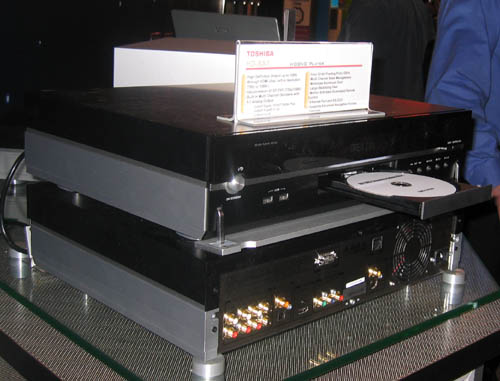
Toshiba's HD-XA1 HD-DVD player, scheduled for release in early Spring, 2006.
And speaking of the Blu-Ray/HD-DVD war, this was one of the main themes of CES this year, with manufacturers in both camps showing late prototype designs of players and some even announcing pricing. It looks likely at this point that HD-DVD will hit the streets first, some time around March or April, 2006 with players by
Toshiba (HD-XA1 - $799, HD-A1 - $499) and
RCA (also offering a $499 player).
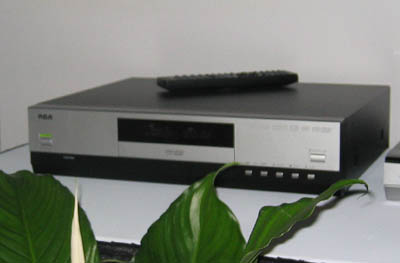
RCA's HD-DVD player will sell for $499 and is expected to ship in April of 2006.
These HD-DVD player prices are much lower than originally expected. Until CES, $999 seemed the price point to beat for HD-DVD and BD. Toshiba is banking that the early launch and lower price point for HD-DVD will set the stage for an early lead in market penetration. But once the BD manufacturers launch their players (expected late spring/summer), there will be many more choices since there are more consumer electronics manufacturers supporting BD than HD-DVD.
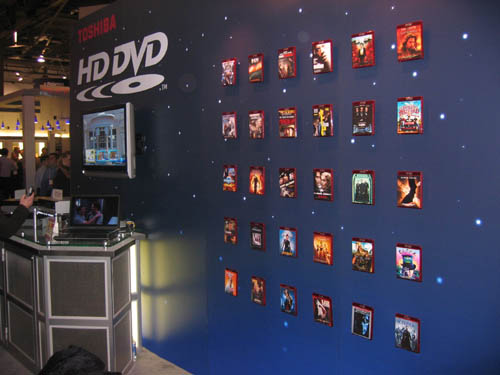
Toshiba's "Wall o HD-DVDs" illustrated some of the movies that will be available on HD-DVD at launch time
Seeing prototype players/discs of both, I'd say either format is more than up to the challenge of delivering high definition movies and music to consumers' homes. HD-DVD's Digital Rights Management and interactivity features may make it more consumer friendly, but Toshiba has its work cut out for itself trying to gain widespread support for a format with fewer manufacturers and studios behind its launch.
But unlike most of the prototype BD players, that were all safely ensconced in Plexiglas cages (the exception being the Pioneer Elite BD player), Toshiba's HD-DVD players were out in the open for us to touch and feel. They were connected via HDMI to HD plasma monitors and making some very pretty pictures and nice sounds. As to whether the analog HD outputs (component video) will be able to put out a true HD 720p or 1080i signal, it appears this decision is going to be left to the content provider to decide. It's very possible that these beautiful HD pictures will be down-res'ed to 480P via the analog component outputs leaving owners of older HDTVs with no digital inputs (DVI-D or HDMI) out in the cold.
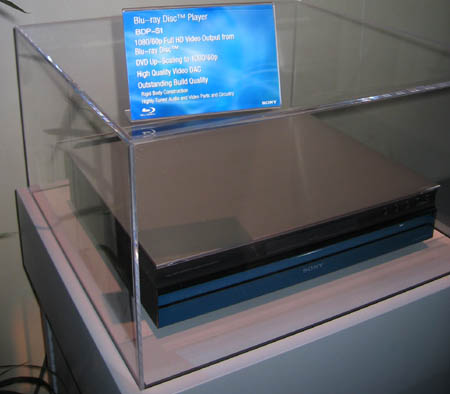
Sony's Blu-Ray Player was safely hidden behind plexiglas
Sony was just one of several manufacturers with BD players on display at CES. The BDP-S1 will feature native output of 1080p (1080 progressive) as well as upscaling of existing DVDs to 1080p. It is expected to ship in the Summer of 2006. Pricing has yet to be determined.
But Blu-Ray was just a part of Sony's push for CES 2006. One of the coolest items they had on display (and in action in the Sony Theater) was their new 4K SXRD-based projector. The SRX-R110 projector ($110,000) features a blinding 10,000 ANSI Lumen rating, 2,000:1 contrast ratio, and 3 distinct SXRD panels with a resolution of 4096X2048 pixels each. Yes, that's four times the resolution of the very best 1080p HDTV source. The picture quality of the SRXR110 was stunning with vivid lifelike colors and no visible pixel structure at 20 feet away on a screen that must have been close to 30 feet diagonally.
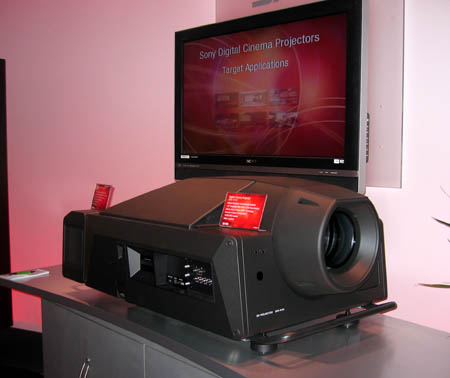
Sony's massive SRX-R110 4K projector. For size reference, that's a 42 inch plasma on the wall above it.
While it is certainly possible that this projector could be used in a home theater (one with LOTS of space), it is primarily intended for use in movie theaters. In fact, Mark Cuban of HDNet has apparently installed these into his Landmark Theater chain across the country so films like Steven Soderbergh's "Bubble" which was shot digitally on Sony's 24p CineAlta camera, will look its best in its theatrical premier later this winter. It's Sony's hope that other theaters will follow suit. Since we at
Big Picture Big Sound have seen our share of crappy out-of-focus movie presentations on old analog projectors at the local cineplex, we certainly wish them the best in this endeavor!
And in the slightly smaller but still BIG PICTURE department, Sony unveiled its 82-inch BRAVIA LCD flat panel prototype television. Delivering full 1920 x 1080 HD resolution, this display is the first Sony Extended Video YCC (xvYCC)-compliant television. This new technology expands color data range and, when combined with Sony's Triluminous LED backlighting system, results in more realistic colors and a more detailed picture than traditional LCD televisions. This statement piece (based on partner Samsung's LCD technology) is not expected in production any time soon, but Sony also announced and showed off more realistically sized models like a new 46 inch Bravia LCD TV scheduled for Spring availability (BRAVIA KDL-46S2000, Available in May for about $4,500).
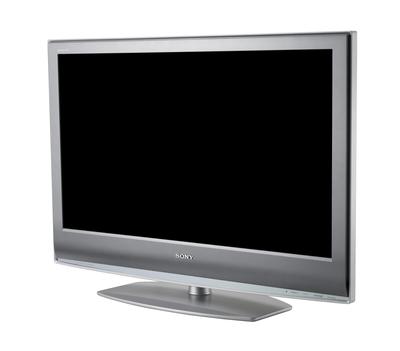
Sony's 46 inch Bravia LCD HDTV.
Sony's other product announcements included a unique electronic book-reader launching this Spring - simply called the Sony Reader - with a high contrast "paper-like" screen that minimizes eye strain and rivals real paper for readability. The Reader allows you to download any of up to 10,000 books and take these along with you in one device about the size of a single paperback book and only ½ inch thick. Using optional memory stick or SD cards, you can store hundreds of books in the reader at any one time.
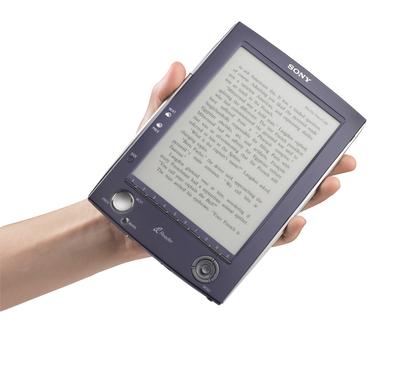
Sony's high-tech new book reader - the Sony Reader - offers a high contrast screen that's easy on the eyes for extended reading.
Sony also announced extensions/enhancements for the popular Play Station Portable (PSP) that will soon allow it to work with Sony's "Location Free TV" server so that PSP users will be able to watch their own TV channels (from cable, broadcast or satellite) or a DVD from their collection, or even monitor a home video camera feed from anywhere in the world that has a wireless hotspot internet connection. Pretty cool for a "video game console."
Other interesting announcements from Sony included a small Bluetooth camcorder microphone that works with Sony's newest 5.1 Channel Dolby Digital enabled DVD camcorders. Using this new bluetooth wireless microphone, you can send a clear vocal feed from up to 90 feet away and this track is recorded as the center channel in the Dolby Digital 5.1-channel mix onto the recordable DVD. This could be quite handy for parents catching their children's important line of dialog in the first grade school play or for weddings for that matter so you can capture those important words without them being drowned in a sea of background noise.
On the home theater computer side of things, Sony's upcoming XL2 "Digital Living System" (pricing TBD) joins the existing model XL1 in this living room-friendly design family, but adds an ATSC tuner for true HDTV support.
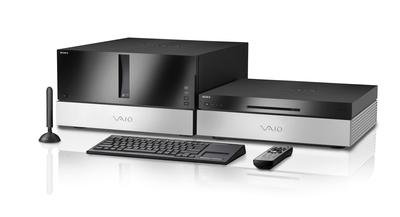
Sony's Digital Living System home theater PCs fit right into a living room or home theater.
Sony's Digital Living System PCs include a tweaked version of Windows Media Center Edition operating system that includes Sony's proprietary "Click to DVD" software, Sony's answer to "iMovie." It's good to see PC manufacturers finally waking up to the fact that for a PC to be able to live happily in a home theater or living room, it has to look more like a DVD player and less like a computer. The XL1 and XL2's horizontal chassis and sleek metal styling fit right in with existing audio video components and help really bring home the promise of computer/home theater convergence.
And speaking of convergence, one company on the leading edge of integrating home entertainment with the PC, albeit in an unusual way is
SlingMedia. As we reported in October's coverage of the
Digital Life show in New York, SlingMedia's "SlingBox" ($249, available now) allows you to hook up your home cable box, DVD, player, Tivo, satellite receiver or OTA tuner to a home network or to the internet. You can then access your own TV channels, Tivo recordings, DVDs, etc. from anywhere in the world with a PC and a high speed internet connection. Need to pass some time at a Starbucks in San Francisco? Whip out your laptop and check out the latest episode of
Battlestar Galactica, recorded back home in New York. And all without any additional monthly service fee.
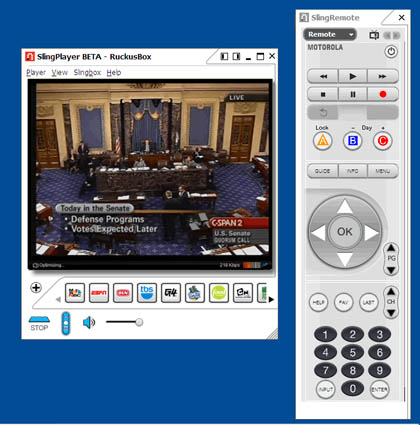
The SlingPlayer software on your PC includes a resizable video screen as well as a "virtual" remote that allows you to control even advanced operations of your entertainment center at home from anywhere in the world.
At CES, SlingMedia announced that they're taking this to the next level with delivery of your home entertainment content directly to any Windows-based cell phone or handheld computer. They demonstrated the new SlingPlayer Mobile technology on a Sprint-based (EVDO network) phone and the image quality was remarkably good considering the nature of the medium. Now you can watch live TV, pre-recorded shows or your own DVDs in a taxi! Let's just hope the cab drivers themselves don't find out about this - I'd rather my driver not be watching "his stories" on my trip to the airport.
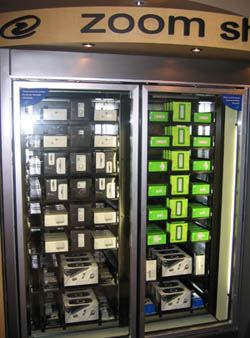
Zoom shop's PSP and iPod vending machine.
And in the "just when you thought you'd seen it all" department... Looking for a gift for that special gadget freak in your life, but you don't want to wait for shipping from an online order and you don't want to deal with standing on line at a store? Try the zoom shop vending machine (located in the Las Vegas Hilton), where you can buy such gadgets as Sony's Play Station Portable (PSP) or an iPod. I hope they're packed well to survive the drop from the top shelf -- kerplunk!
Read on in
Part III of this report, featuring
Polk Audio, Samsung, Dolby TrueHD and more











